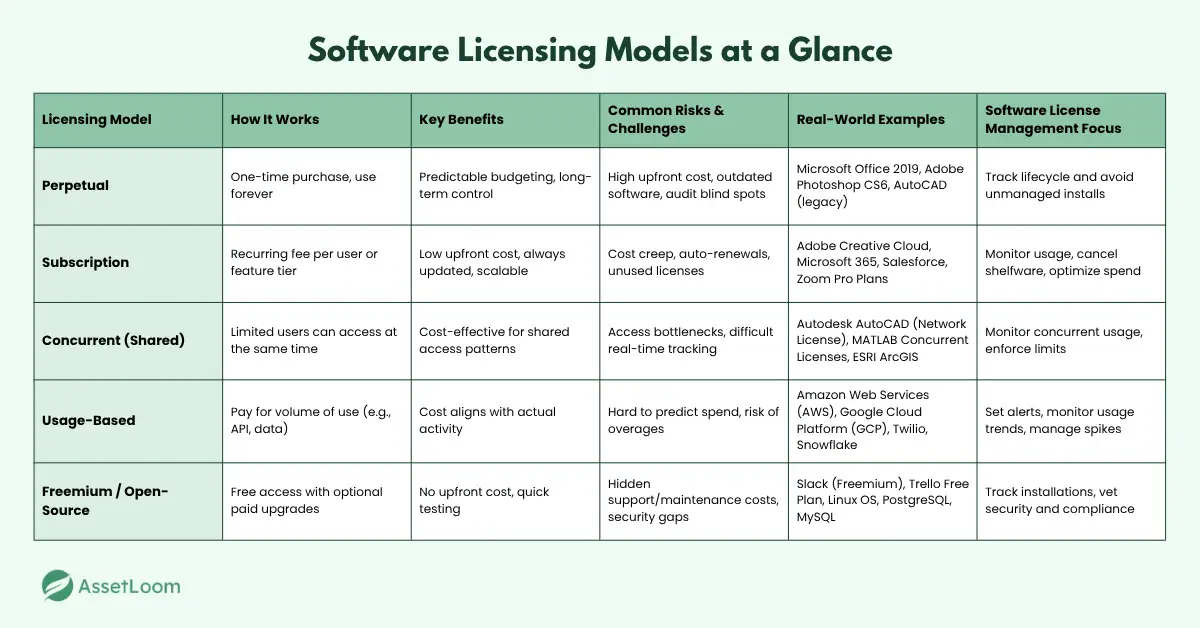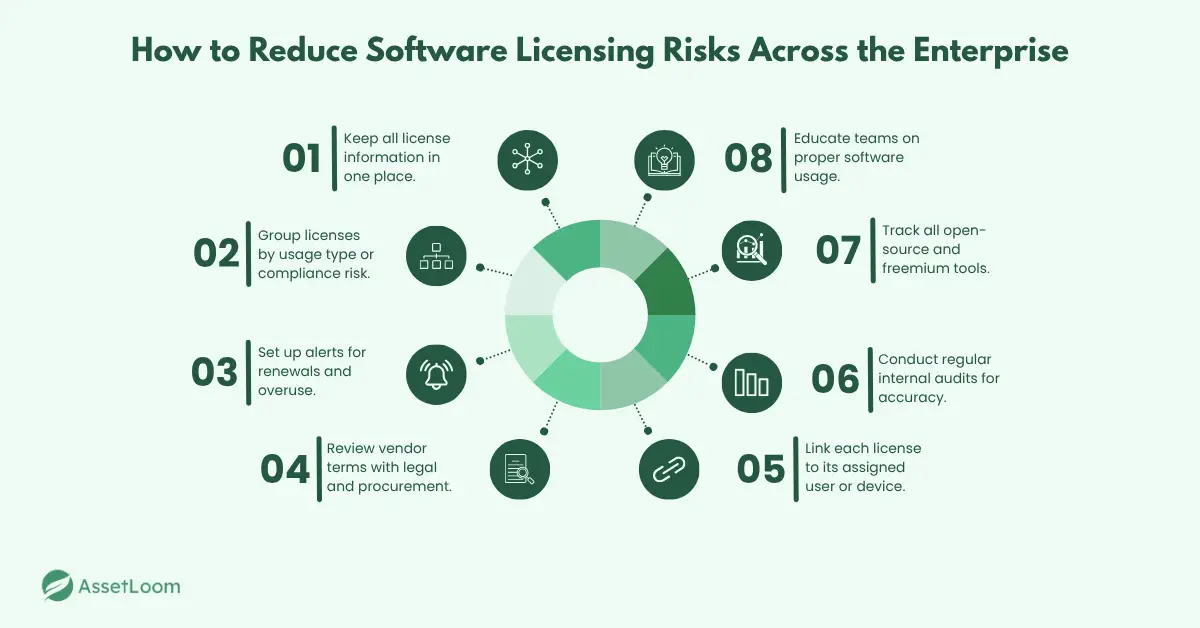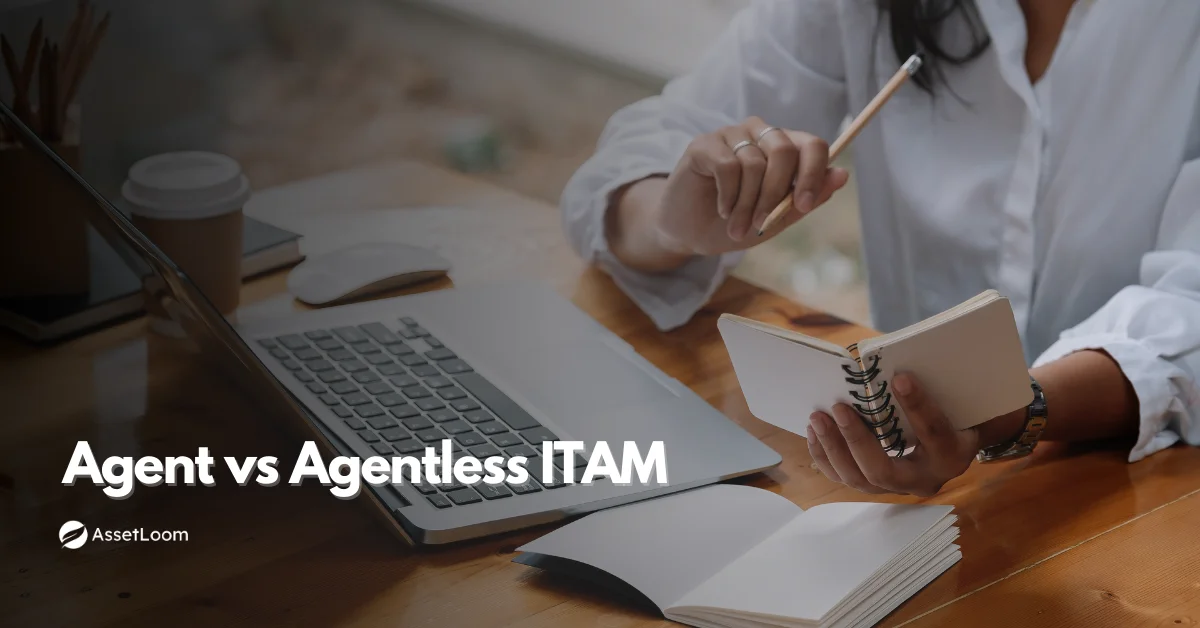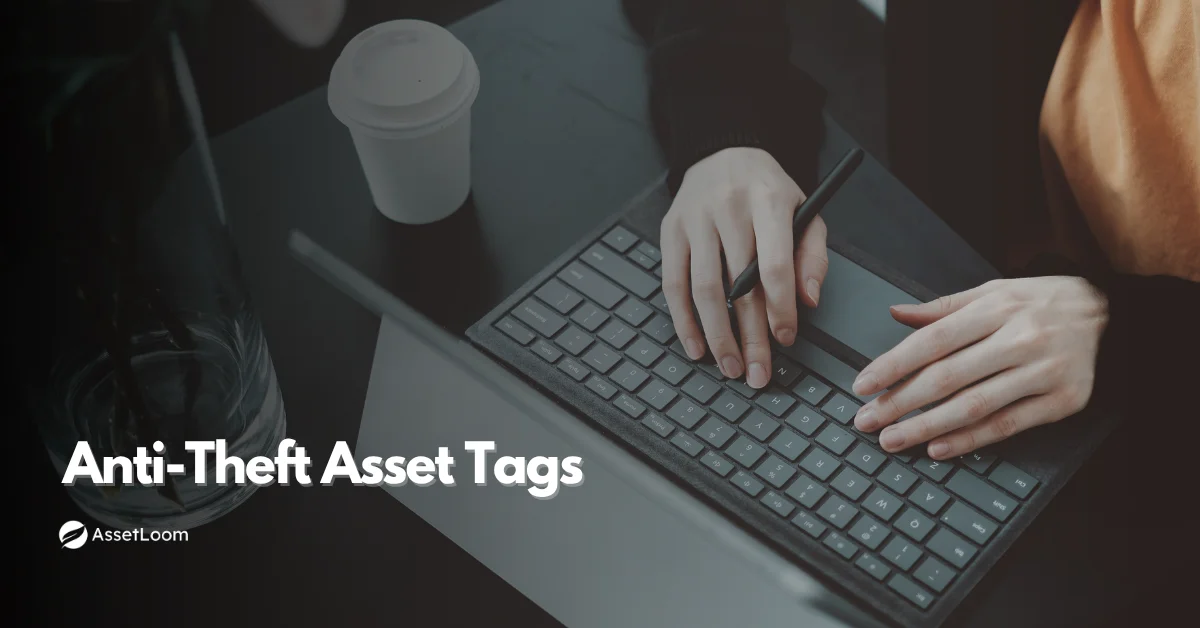Exploring Software Licensing Models: Costs, Flexibility, and Risks
Learn how different software licensing models impact cost, compliance, and scalability. A deep dive for IT and procurement leaders making smarter decisions.
Software licensing has quietly become a growing pain for many businesses. What was once a simple purchase is now a mix of subscription tiers, usage caps, and complex renewals.
IT teams face pressure to stay compliant without overspending. Finance struggles with unpredictable costs. Procurement negotiates contracts without full insight into what’s actually being used.
The result? Wasted spend, audit risks, and licensing models that can’t keep up with how the business operates.
This blog takes a closer look at the most common software licensing models and how each one affects cost, flexibility, and risk, so organizations can make smarter, more strategic decisions.
Understanding the Core Types of Software Licensing Models
Before any business can take control of software costs or stay audit-ready, it needs a clear understanding of what it’s actually paying for. That means looking beyond just names like "subscription" or "perpetual" and really understanding how each model works in the real world.
Each licensing model affects more than just pricing. It changes how flexible your teams can be, how complicated renewals get, and how risky it is if things fall through the cracks. That’s why software license management isn’t just about keeping track of license keys. It’s about building smarter systems for control, visibility, and accountability.
Let’s break down the most common licensing models businesses deal with today.
Perpetual Licensing
This is the old-school model: pay once, use forever. Sounds simple, and in some ways, it is. It’s still popular in industries that value stability and long-term planning, like healthcare or manufacturing.
Why some teams still prefer it:
- It’s a one-time purchase, so you’re not tied to ongoing payments
- Budgeting is straightforward and handled as a capital expense
- You control when or if you upgrade
But here’s the catch:
- Support eventually runs out, leaving teams with outdated software
- Upfront costs are high, especially for large deployments
- Without good license tracking, old installations get lost, and audits get messy
Example: Microsoft Office 2019 is a common perpetual license, with a one-time payment per device.
In terms of software license management, perpetual licenses often go unmanaged after initial deployment. Over time, that creates blind spots that can hurt when it's time to upgrade, consolidate, or prove compliance.
Subscription Licensing
This is now the default for most SaaS tools. You pay monthly or annually, and you’re usually charged per user or based on a feature tier.
Why teams like it:
- Low upfront cost makes it easier to adopt new tools
- You always get the latest features and updates
- Easy to scale by adding or removing users as needed
Where it goes wrong:
- Costs can sneak up quickly, especially with unused or duplicate licenses
- Auto-renewals often happen before teams realize what they’re actually using
- Over-licensing is common when companies pay for “just in case” users who never log in
Example: Adobe Creative Cloud uses a subscription model billed monthly or annually per user.
That’s why software license management is critical here. Without visibility into usage, companies bleed money on shelfware. Worse, they end up with a bloated tech stack full of tools no one is using, but everyone is still paying for.
Concurrent (or Shared User) Licensing
Instead of licensing every individual user, concurrent licensing only counts the number of people using the software at the same time. It’s common for specialized tools like CAD or engineering software.
Where it shines:
- Ideal for shift-based work or shared systems
- Cost-effective when many users only need occasional access
But challenges show up fast:
- Usage spikes can lock users out unexpectedly
- Hard to track in real time without strong monitoring
- Compliance issues if teams bypass license limits without realizing it
Example: Autodesk AutoCAD offers concurrent licensing options for teams with shared access needs.
In this case, software license management isn’t just about counting licenses. It’s about monitoring actual usage, spotting bottlenecks, and making sure your team stays within bounds.
Usage-Based Licensing
This model charges based on how much you use the software. Think API calls, number of transactions, storage used, or processing time. It’s common in cloud platforms and developer tools.
Why it’s appealing:
- Pay only for what you use
- Great for unpredictable workloads
- Cost ties directly to business activity
But it comes with risk:
- Budgeting becomes harder since one busy month can blow past forecasts
- No usage caps can lead to surprise bills
- Difficult to predict annual costs, especially for growing teams
Example: Amazon Web Services (AWS) bills based on compute time, storage usage, and API activity.
With usage-based models, software license management needs to shift from static tracking to dynamic monitoring. It’s about setting alerts, watching trends, and building controls into procurement and finance processes.
Freemium and Open-Source Licensing
At first glance, these look like a win. Free tools, open codebases, no licensing costs. But that doesn’t mean they’re risk-free.
When it makes sense:
- For pilot projects or non-critical workloads
- Teams with developers who can support and customize tools internally
The reality:
- No dedicated support or guaranteed updates
- Features are often gated behind a paid tier
- Integration and maintenance costs can outweigh initial savings
Example: Slack offers a freemium model, with core features available for free and advanced ones behind a paid tier.
Even free tools need to be part of your software license management plan. Open-source components often get buried in codebases or systems, and without visibility, they can cause problems during audits or security reviews.
Bottom line
Every licensing model has trade-offs. What works for a fast-moving SaaS team might be a nightmare for a highly regulated enterprise. That’s why smart software license management starts with understanding how each model works, not just on paper but in the day-to-day operations of your business.

What Software Licensing Models Really Cost
Software licensing models don’t just impact how software is purchased; they shape long-term budget planning, cost control, and compliance exposure. Here’s what businesses often overlook when estimating the real price of licensing.
Perpetual Licensing: High Upfront, Hidden Ongoing Costs
Perpetual models require a large one-time payment, but ongoing maintenance and support are rarely optional. Compatibility fixes and version upgrades also drive long-term costs.
Example: Microsoft Office 2019 may need extended support contracts as systems evolve.
Subscription Licensing: Predictable Until It Isn’t
Subscriptions offer predictable monthly or annual billing, but scale too fast, and the costs snowball. Seat creep, unused accounts, and feature overkill often go unnoticed.
Example: Adobe Creative Cloud renews for inactive users unless carefully tracked.
Usage-Based Licensing: Flexible but Unstable
Pay-as-you-go models match real usage, but budgeting is difficult when workloads spike. Without monitoring, organizations risk unexpected overages.
Example: AWS EC2 charges climb quickly when developers leave testing environments running.
The Cost of Unused Licenses vs. Non-Compliance
Unused licenses quietly waste budget. But under-licensing or misuse can lead to audits, penalties, and legal trouble. Most businesses struggle to strike the right balance.
How Software Licensing Models Affect TCO
A model that looks cost-effective today may prove expensive long-term. Understanding total cost of ownership (TCO) means factoring in updates, usage patterns, compliance, and change management.
To manage TCO effectively:
- Monitor actual usage, not just access
- Review and optimize licenses regularly
- Align licensing models with business goals and operational needs
How Software Licensing Models Affect Flexibility and Business Growth
Software licensing models directly impact how easily your organization can adapt to change. Whether you're hiring quickly, supporting remote teams, or launching new projects, your licensing approach needs to support growth without creating delays or unnecessary costs.
Key considerations:
- Can you add or remove licenses as staffing changes occur?
- Are you tied to long-term contracts that limit your options?
- Does your licensing model support remote and hybrid work environments effectively?
What to know:
- Subscription models are often a good choice for growing teams. They allow for quick access to tools and regular updates. However, without clear visibility, it is common to continue paying for users who no longer need access.
- Perpetual licenses are still valuable in stable environments such as healthcare, manufacturing, or finance. They offer control and long-term ownership, but they are less flexible when changes are needed.
- Freemium and open-source software are useful for testing or short-term use, but scaling often requires upgrading or managing additional complexity.
Licensing should not slow down your business. Choose models that match your pace and structure.
Software Licensing Models and the Risk of Non-Compliance
Poor enterprise software license management can result in financial penalties, legal issues, and operational disruptions. The risks often go unnoticed until they cause real damage.
Common challenges:
- Audit risk: Vendors may audit software usage and charge penalties for overuse or violations of licensing terms.
- Tracking in hybrid environments: Managing licenses across cloud, on-premise, and personal devices is difficult without a centralized system.
- Vendor lock-in: Some licensing agreements make it difficult to switch providers or cancel services without additional costs.
- Compliance requirements: Licensing choices can affect your ability to meet standards such as GDPR, HIPAA, or ISO 27001. Using the wrong license or losing track of open-source components may result in compliance failures.
Example: A team uses an open-source tool that is not properly documented. Later, during a security or regulatory review, the tool is flagged, creating delays and requiring urgent remediation.
Recommended actions:
- Maintain a single source of truth for all licenses, including free or trial versions
- Automate renewal tracking and usage monitoring
- Review vendor contracts with procurement and legal to understand terms and obligations
Managing risk starts with visibility. The right software licensing model helps prevent issues before they become costly.

Conclusion
Software licensing models affect more than just how you pay for tools; they shape your budget, flexibility, and risk. The right model depends on how your team works, how fast you’re growing, and what compliance rules you need to meet.
There’s no one-size-fits-all answer, but with a clear understanding of each model, you can avoid unnecessary costs and stay in control. The goal is simple: choose licensing that works for your business today and can adapt to whatever comes next.

Subscribe for Expert Tips and Updates
Receive the latest news from AssetLoom, right in your inbox.

